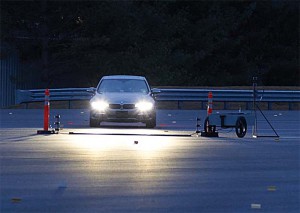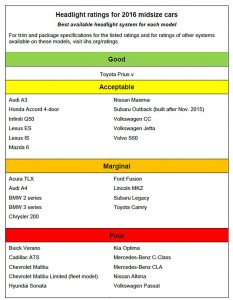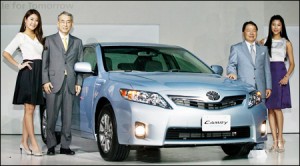They’re among the most basic safety devices found on every vehicle on the market, yet nearly 120 years after the invention of the electric headlight, most still fall short of effectively lighting the way, according to a new study by the Insurance Institute for Highway Safety.
In its first-ever test of headlights, the insurance trade group found only one of the 31 midsize vehicles it tested – the Toyota Prius V, earned a “good” rating, with another 11 rated “acceptable.” The rest of the group were in need of serious improvement, according to the IIHS.
“If you’re having trouble seeing behind the wheel at night, it could very well be your headlights and not your eyes that are to blame,” said IIHS executive vice president and chief research officer David Zuby.
(Legislation, not technology, likely to delay launch of autonomous vehicles. Click Here for more.)
The earliest vehicles used lamps burning acetylene or oil. Primitive electric lights were first introduced as an option in 1898 on the Columbia Electric Car. By 1910, a number of vehicles had made them standard. Dual high-low beams soon followed.
Today, headlights came in a variety of sizes and shapes, and use a wide range of technologies. That includes classic incandescent bulbs, as well as more advanced HID, halogen and LED lamps. BMW introduced the first laser headlamp on its i8 plug-in hybrid, though that technology has not yet approved by federal regulators for sale in the U.S.
But even the most modern technologies aren’t necessarily the most effective, the study found. In fact, it’s not necessarily the bulb itself that makes the big difference.
“We found the same light bulb, depending upon what reflector or lens it’s paired with and how it’s mounted on the vehicle, can give you very different visibility down the road,” Zuby said.
The Toyota Prius V received the only “good” rating among the 31 models tested, the IIHS reporting it delivered enough light for a driver to spot a car, pedestrian, bicycle or some other object as much as 387 feet ahead. That would provide a driver enough time to come to a complete, safe stop.
By comparison, the halogen headlamps used by the BMW 3-Series were rated the worst of the 31 models tested, delivering enough illumination only to spot obstacles at 128 feet. That would barely provide a driver enough warning to come to a stop at speeds of no more than 35 mph, according to the IIHS.
The BMW was one of a group of 10 models to be rated “poor,” with another nine falling into the “marginal” category.
(NHTSA chief wants to boost public response to recalls. Click Here for the full story.)
The weak performance of so many of today’s vehicle headlamps comes as a surprise considering manufacturers have made lighting an issue they frequently focus on when describing new models. But often, the emphasis is on the look of their lamps, not necessarily the performance.
Despite being described as offering the latest in lighting technology, the halogen and LED lamps in the new Mercedes-Benz C-Class and CLA models both fell into the “poor” category. Indeed, vehicle price is no guarantee of effective headlights. The Cadillac ATS and the mid-luxury Buick Verano both were rated “poor.”
The study touches on a critical yet largely ignored issue. Of the more than 32,000 highway deaths that occurred in 2014, the last year for which full data are available, roughly half occurred after dark.
The IIHS tested 31 vehicles, but the process actually covered 82 different headlight systems, as some vehicles offer more advanced lighting options. To get the most effective lighting with the Toyota Prius V, for example, a motorist would have to order the optional advanced technology package – which is only available on the hybrid’s most expensive trim model. Other versions of the Prius V with standard halogen lights ranked “poor.”
But that’s not always the case. The optional LED system on the Honda Accord sedan earned a “marginal” rating, while the basic halogen lamps rated “acceptable.”
The IIHS decided to create its own lighting tests because it felt the federal government guidelines were out of date. The National Highway Traffic Safety Administration essentially measures light output immediately in front of a vehicle. The insurance group instead measured light from both low and high beams as vehicles were driven along five different paths, including curves and straight roads.
And new lights designed to “bend” into corners didn’t necessarily fare well, either. Curve-adaptive systems on the Cadillac ATS, Kia Optima and Mercedes C-Class also rated “poor.”
In a statement, Mercedes said it was “greatly surprised” by the IIHS test results, adding that the carmaker was “confident our lighting systems provide important safety benefits for real world conditions.”
BMW also challenged the results of the test.
(Autonomous vehicles likely to mean lower insurance rates. Click Here for the story.)




The unified headlight arrays beg to be problematic. My Jetta has a great low beam pattern, but high beams don’t extend the vision range since they cover essentially the same area. And they can’t be adjusted – only the entire light unit can be moved. The best lights on any of my cars? 1962 Mercedes over and under halogen “old-style” lights.
The Prius photo has a curious spelling on the front license plate.
Bob Wilson, Huntsville, AL
I am glad that the IIHS has called attention to this topic. Not only is there no consistency in the quality of light available to drivers of these cars, but many of these lights are absolutely blinding to cars coming in the opposite direction.
I am reluctant to suggest this, but if the government really does want to “help” they should set new performance standards for where light falls on the road and and how much it drifts into oncoming traffic.
You also might have noticed that modern headlights often obscure your ability to see turn signals in an integrated light unit.
New headlights are super bright, but they don’t help you or your fellow drivers see anything!
GM has some issues with their headlights on their trucks and their sedans. They do not give enough light to see anything on the side of the road. There is a Technical Bulletin out on the lights but I am not sure that is a good fix. Many still complain even after the upgrade.
I am shock that the great Consumer Reports is not running this article instead of the Insurance Lobbyist group.
Auto makers are trying to make their headlight that fit more into their design of the auto and less on functionality and safety of their lights and auto.
They need to set some standards on Headlight and Rear lights, too. Do away with these blinding Blue lights in headlights. Some lights are just too bright, too…when coming down the road at you.
And stop adding red lens to turn lights. Separate them in color from brake lights. They use to be yellow or a different color than brake lights.
I just as soon have the old seal beams light than all this newer junk that is more into design than into lightning ability.
I do like the progressive (or sequential) lights on the new Audi A4. It clearly shows which direction you’re turning.
Paul E.